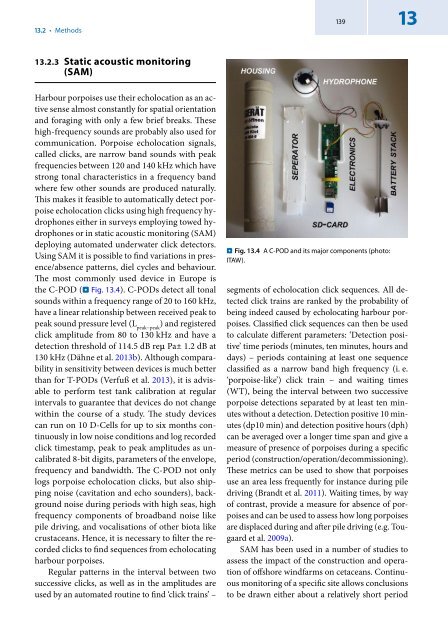bok%3A978-3-658-02462-8.pdf?auth66=1398409209_a0514c2b8e531c058ab8b810a0cad74d&ext=
bok%3A978-3-658-02462-8.pdf?auth66=1398409209_a0514c2b8e531c058ab8b810a0cad74d&ext=
bok%3A978-3-658-02462-8.pdf?auth66=1398409209_a0514c2b8e531c058ab8b810a0cad74d&ext=
- No tags were found...
Create successful ePaper yourself
Turn your PDF publications into a flip-book with our unique Google optimized e-Paper software.
13.2 • Methods139 1313.2.3 Static acoustic monitoring(SAM)Harbour porpoises use their echolocation as an activesense almost constantly for spatial orientationand foraging with only a few brief breaks. Thesehigh-frequency sounds are probably also used forcommunication. Porpoise echolocation signals,called clicks, are narrow band sounds with peakfrequencies between 120 and 140 kHz which havestrong tonal characteristics in a frequency bandwhere few other sounds are produced naturally.This makes it feasible to automatically detect porpoiseecholocation clicks using high frequency hydrophoneseither in surveys employing towed hydrophonesor in static acoustic monitoring (SAM)deploying automated underwater click detectors.Using SAM it is possible to find variations in presence/absencepatterns, diel cycles and behaviour.The most commonly used device in Europe isthe C‐POD (. Fig. 13.4). C‐PODs detect all tonalsounds within a frequency range of 20 to 160 kHz,have a linear relationship between received peak topeak sound pressure level (L peak−peak) and registeredclick amplitude from 80 to 130 kHz and have adetection threshold of 114.5 dB reµ Pa± 1.2 dB at130 kHz (Dähne et al. 2013b). Although comparabilityin sensitivity between devices is much betterthan for T‐PODs (Verfuß et al. 2013), it is advisableto perform test tank calibration at regularintervals to guarantee that devices do not changewithin the course of a study. The study devicescan run on 10 D‐Cells for up to six months continuouslyin low noise conditions and log recordedclick timestamp, peak to peak amplitudes as uncalibrated8‐bit digits, parameters of the envelope,frequency and bandwidth. The C‐POD not onlylogs porpoise echolocation clicks, but also shippingnoise (cavitation and echo sounders), backgroundnoise during periods with high seas, highfrequency components of broadband noise likepile driving, and vocalisations of other biota likecrustaceans. Hence, it is necessary to filter the recordedclicks to find sequences from echolocatingharbour porpoises.Regular patterns in the interval between twosuccessive clicks, as well as in the amplitudes areused by an automated routine to find ‘click trains’ –..Fig. 13.4 A C‐POD and its major components (photo:ITAW).segments of echolocation click sequences. All detectedclick trains are ranked by the probability ofbeing indeed caused by echolocating harbour porpoises.Classified click sequences can then be usedto calculate different parameters: ‘Detection positive’time periods (minutes, ten minutes, hours anddays) – periods containing at least one sequenceclassified as a narrow band high frequency (i. e.‘porpoise-like’) click train – and waiting times(WT), being the interval between two successiveporpoise detections separated by at least ten minuteswithout a detection. Detection positive 10 minutes(dp10 min) and detection positive hours (dph)can be averaged over a longer time span and give ameasure of presence of porpoises during a specificperiod (construction/operation/decommissioning).These metrics can be used to show that porpoisesuse an area less frequently for instance during piledriving (Brandt et al. 2011). Waiting times, by wayof contrast, provide a measure for absence of porpoisesand can be used to assess how long porpoisesare displaced during and after pile driving (e.g. Tougaardet al. 2009a).SAM has been used in a number of studies toassess the impact of the construction and operationof offshore windfarms on cetaceans. Continuousmonitoring of a specific site allows conclusionsto be drawn either about a relatively short period




